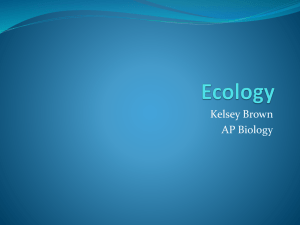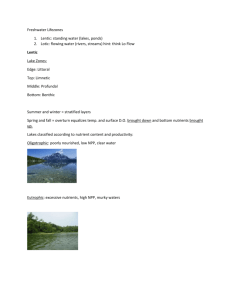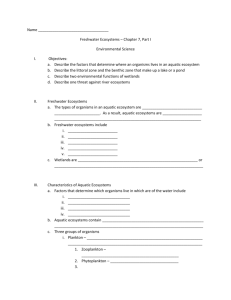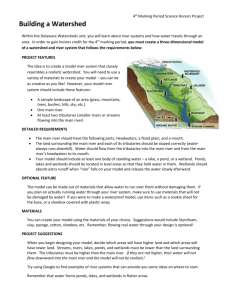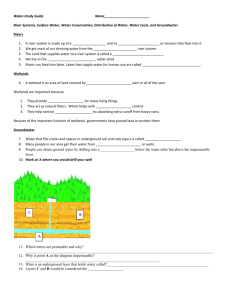RIVERS, LAKES AND WETLANDS (EEC320/ENVIRON311
advertisement
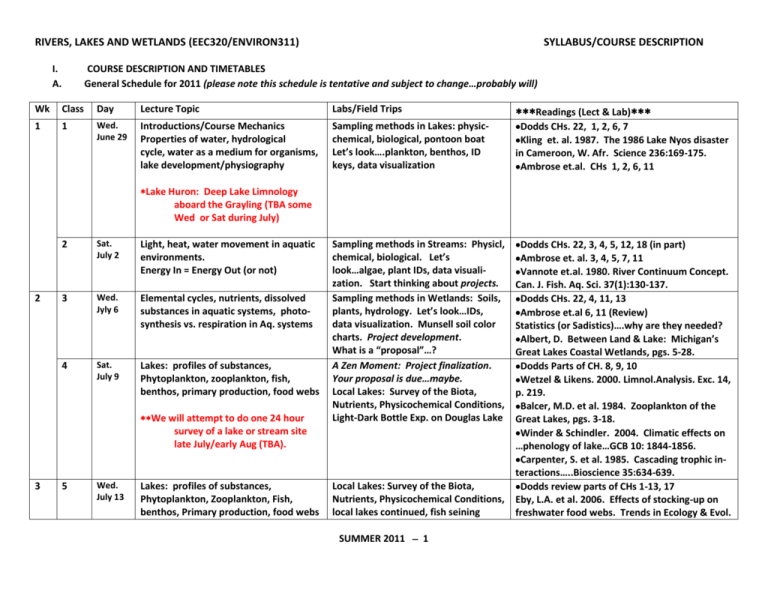
RIVERS, LAKES AND WETLANDS (EEC320/ENVIRON311) I. A. SYLLABUS/COURSE DESCRIPTION COURSE DESCRIPTION AND TIMETABLES General Schedule for 2011 (please note this schedule is tentative and subject to change…probably will) Wk Class Day Lecture Topic Labs/Field Trips Readings (Lect & Lab) 1 1 Wed. June 29 Introductions/Course Mechanics Properties of water, hydrological cycle, water as a medium for organisms, lake development/physiography Sampling methods in Lakes: physicchemical, biological, pontoon boat Let’s look….plankton, benthos, ID keys, data visualization Dodds CHs. 22, 1, 2, 6, 7 Kling et. al. 1987. The 1986 Lake Nyos disaster in Cameroon, W. Afr. Science 236:169-175. Ambrose et.al. CHs 1, 2, 6, 11 Sampling methods in Streams: Physicl, chemical, biological. Let’s look…algae, plant IDs, data visualization. Start thinking about projects. Sampling methods in Wetlands: Soils, plants, hydrology. Let’s look…IDs, data visualization. Munsell soil color charts. Project development. What is a “proposal”…? A Zen Moment: Project finalization. Your proposal is due…maybe. Local Lakes: Survey of the Biota, Nutrients, Physicochemical Conditions, Light-Dark Bottle Exp. on Douglas Lake Dodds CHs. 22, 3, 4, 5, 12, 18 (in part) Ambrose et. al. 3, 4, 5, 7, 11 Vannote et.al. 1980. River Continuum Concept. Can. J. Fish. Aq. Sci. 37(1):130-137. Dodds CHs. 22, 4, 11, 13 Ambrose et.al 6, 11 (Review) Statistics (or Sadistics)….why are they needed? Albert, D. Between Land & Lake: Michigan’s Great Lakes Coastal Wetlands, pgs. 5-28. Dodds Parts of CH. 8, 9, 10 Wetzel & Likens. 2000. Limnol.Analysis. Exc. 14, p. 219. Balcer, M.D. et al. 1984. Zooplankton of the Great Lakes, pgs. 3-18. Winder & Schindler. 2004. Climatic effects on …phenology of lake…GCB 10: 1844-1856. Carpenter, S. et al. 1985. Cascading trophic interactions…..Bioscience 35:634-639. Dodds review parts of CHs 1-13, 17 Eby, L.A. et al. 2006. Effects of stocking-up on freshwater food webs. Trends in Ecology & Evol. Lake Huron: Deep Lake Limnology aboard the Grayling (TBA some Wed or Sat during July) 2 2 Sat. July 2 Light, heat, water movement in aquatic environments. Energy In = Energy Out (or not) 3 Wed. Jyly 6 Elemental cycles, nutrients, dissolved substances in aquatic systems, photosynthesis vs. respiration in Aq. systems 4 Sat. July 9 Lakes: profiles of substances, Phytoplankton, zooplankton, fish, benthos, primary production, food webs We will attempt to do one 24 hour survey of a lake or stream site late July/early Aug (TBA). 3 5 Wed. July 13 Lakes: profiles of substances, Phytoplankton, Zooplankton, Fish, benthos, Primary production, food webs Local Lakes: Survey of the Biota, Nutrients, Physicochemical Conditions, local lakes continued, fish seining SUMMER 2011 1 RIVERS, LAKES AND WETLANDS (EEC320/ENVIRON311) 4 5 6 6 Sat. July 16 Streams: flowing water, habitats, macroinvertebrates, algae, plants, benthos 7 Wed. July 20 Streams: flowing water, habitats, benthos, fish, surface water-ground water interaction (hyporheic zones) 8 Sat. July 23 Streams: continued 9 Wed. July 27 10 Sat. July 30 11 Wed. Aug. 3 SYLLABUS/COURSE DESCRIPTION Local Streams: survey of algae, bugs, nutrients, physicochem conditions, local streams, stream metabolism experiment (24 hr. DO) Making burn mounts (diatoms) Using keys: Hilsenhoff’s Aq. Insect, Prescott’s Algae of the Great Lakes, Weber’s Guide to Common Diatoms, Balcer’s Zoops of the Great Lakes Local Streams: survey of biota, nutrients, physicochem conditions, local streams, electroshocking fish demo Continued sampling/examples/finish lab exercizes, compile all ID data Streams: continued Continued sampling/examples/finish lab exercizes, compile all ID data Wetlands: Definition and wetland types, Wetland Surveys of soils, hydrology, hydrology, soils, indicator plants, aquatic vasc. Plants, etc., using the zonation Munsell Soil color charts, soil coring Wetlands: Structure, function, Local Wetlands Newmaster etal.’s, Wetland Plants of Ontario, Fassett’s Manual of Aquatic Plants SUMMER 2011 2 21(10):576-584. Baxter, C.V. et al. 2005. Tangled webs: reciprocal flows of invertebrate prey link streams and riparian zones. Freshw Biol 50:201-220. Dodds, review CHs 3-12 Dixit, S.S. et al. 1992. Diatoms: Powerful indicators of environmental change. Env. Sci.&Tech. 26:22-33. Wallace et al. 1997. Multiple trophic levels of a forest stream linked to terrestrial litter inputs. Science 277: 102-104. Dodds Ch 17, 21 Winter, T.C. et al. 1998. Ground Water and Surface Water. USGS Circ. 1139. White et al. 1987. Temperature profiles … JNABS 6: 85-91. White, D.S. 1990. Biological relations to convective flow patterns….Hydrobiol 196:148-159. Hendricks & White 1991. Physicochemical patterns within a hyporheic zone…Can.J. Fish. Aq. Sci. 48:1645-1654. Williams, D.D. 1984. The hyporheic zone as a habitat for aquatic insects…. TBA Dodds CH. 18, 19 Albert, D. Between Land & Lake: pgs. 30-72. Mitsch & Gosslink. Wetlands. TBA Mitsch & Gosslink. Wetlands. TBA Albert, D. Between Land & Lake: pgs. 73-85. RIVERS, LAKES AND WETLANDS (EEC320/ENVIRON311) 7 8 12 Sat. Aug. 6 13 Wed. Aug. 10 14 Sat. Aug. 13 15 Wed. Aug. 17 16 Sat. Aug. 20 Wetlands: Restoration, ecosystem services Wetlands: restoration techniques, pollution, eutrophication Tie up loose ends, Discuss the open book final Class project presentations (a.m.) Receive the Final Exam (Final Moment of Zen) Student Symposium (stationwide) Final Exam Due by 5:00 p.m. SYLLABUS/COURSE DESCRIPTION Local Wetlands Chadde’s Great Lakes Wetland Flora Local Wetlands Pop Quiz? Organize for practicum/final Pop Quiz? Lab Clean Up Field Practicum (p.m.) Final Project Report Due Mitsch & Gosslink. Wetlands. TBA Albert, D. Between Land & Lake: pgs. 73-85. Mitsch & Gosslink. Wetlands. TBA Attendance Required TBA TBA TBA We will plan a field trip to Lake Huron (from Cheboygan harbor) during the month of July to do some deep lake sampling. Fun!!! We will attempt to do one 24-hour sampling of a stream or lake site during the session. This will give you the opportunity to see diel processes occurring over 24 hours that you would not see on just a day trip to the site. This will be a team effort and require planning ahead. Required readings (articles, booklets, etc.) other than the required texts (Dodds, Ambrose et al.) will be available in triplicate in the lab. You do not need to copy or purchase these readings. SUMMER 2011 3 RIVERS, LAKES AND WETLANDS (EEC320/ENVIRON311) SYLLABUS/COURSE DESCRIPTION B. Course summary This course examines the structure and function of freshwater ecosystems with an emphasis on the ecological concepts needed to understand these systems and their communities. We will learn about aquatic ecosystems through lecture, field, and laboratory studies in a variety of aquatic habitats mostly within the vicinity of Douglas Lake. Required texts for this course are: Dodds, W.K. 2002. Freshwater Ecology, Concepts and Environmental Applications. Academic Press, San Diego, CA. [the 2010 2nd Edition is alright to use, but I will be using the 1st Edition] Ambrose, H.W. and K.P. Ambrose. 2002. A Handbook of Biological Investigation. Hunter Textbooks, Winston-Salem, NC. Handouts and other readings will be available in the lab or in LaRue Library. C. Course Components The course has four components: 1. Lecture a. Purpose: Lectures will provide much of the theory and basic information on aquatic habitats and communities, how they are structured and why. b. Written exams: There will be one comprehensive take-home open-book final exam. This exam will cover material presented in lecture, readings in the texts and other references, and concepts and principles applied in field settings throughout the course. The exam will be due by 5:00 p.m. the last day of class (Aug. 20). 2. Field Trips a. Purpose: It is important to know where aquatic organisms live within the habitats we will see, and to understand how and why plants and animals are collected, and how the physical habitat is measured and evaluated. Aquatic ecologist use various sampling paraphernalia to understand physical, chemical and biological components of aquatic ecosystems. Field trips will be made to a variety of lake, stream, and wetland habitats. Field trips will usually take place immediately after the morning lectures, regardless of weather conditions. We often will have lunch in the field, so come prepared with a packed field lunch. SUMMER 2011 4 RIVERS, LAKES AND WETLANDS (EEC320/ENVIRON311) SYLLABUS/COURSE DESCRIPTION b. Content: Weeks 1-2 will be mostly learning and practicing methods of aquatic organism collection, the use of sampling equipment for measuring and describing habitat physical and chemical conditions, the use of organism identification references. The first few meetings we will visit lake, stream, and wetland habitats in order to get students oriented to these ecosystems and start thinking about individual research projects. After the 2nd week we will spend several continuous sessions (3-4) on lakes, streams, and wetlands, respectively. After the first couple of weeks of methods training, students will apply what they learn in pursuit of their own research questions. Each student will be expected to write a “proposal” outlining their research question (hypothesis), their methods to be used, experimental design, data collection, data analysis, and finally, writing a formal paper presenting their project results. The instructor and teaching assistant will work with individual students during these important steps. A final oral presentation of individual projects will take place the next to last day of class. c. Ethics: Aquatic organisms (fish, macroinvertebrates, etc.), like all organisms and the environment, must be treated with care and consideration. Professional collection ethics require that we seek to preserve only enough organisms to meet our learning needs. Others will be released back into their natural habitat after data have been recorded. d. Field Work: You will be responsible for both your own personal gear and gear to be used collectively by all class members in order to make your experience enjoyable and safe. It must be stressed that personal safety is of the utmost importance and students will be expected to behavior accordingly. e. Personal gear: The following are typical basic personal needs for field trips. Notebook (waterproof, Rite-in-the-Rain® is OK to use) Pencil Penknife Forceps Waterproof chest waders (required for electroshocking, and sharp objects on the bottom of lakes, streams and wetlands Footwear to work in water when waders are not required; boots, old sneakers are fine; flip-flops and/or bare feet will not be allowed! Rain gear, rain or sun hat Towel (optional) Bug repellent f. Class Gear: On every field trip, students will be assigned various pieces of equipment. Each student will take responsibility for use of the assigned gear by SUMMER 2011 5 RIVERS, LAKES AND WETLANDS (EEC320/ENVIRON311) SYLLABUS/COURSE DESCRIPTION the whole class for the day of the field trip. Responsibilities will include collecting gear from storage, checking that it is in good working condition, ensuring it is taken on a field trip, properly cared for after the trip, and returned to storage in working condition. For certain equipment (flow meters, Hydrolab, etc.) the responsible student will take the appropriate physical measurements to be used by the whole class. Every student will have an opportunity to use and care for all equipment used. g. Procedures on returning to the lab: On returning from the field, all students must; Ensure that live organisms are cared for in tanks, buckets, in the boat well facilities, or in the class-room. Ensure that equipment is cared for properly. Review field notes and append or complete any missing data. Give your notes to the group in charge of group field notes so they can complete the notes for the class. Sort, identify, and examine live and/or preserved material. All organisms must be identified from each trip by the next class meeting. If we are preserving organisms, they must be picked out of buckets, bags, or other transfer containers as soon as possible and transferred to 70% ethanol in viles, labeled, catalogued and stored in a designated laboratory area. Combine identified and labeled organisms from each site into a single container (jar or vial). Put a label identifying the organisms in each vial or jar with family name, common name or other taxon in each container. Also put in each container a label giving collection site, date, and your name. Use soft pencil for all labels in jars or vials ! Restock formalin or 70% alcohol for use on the next field trip or lab exercise. h. Laboratory exams and field notes/equipment grading: There will be two field experiments and two demonstrations of the use of environmental sensor (buoy) data for lake characterization. You will be doing some basic calculations on some aspect of data collected each day in the field. You will be evaluated, in part, based on your ability to carry out very basic calculations, make graphs, and analyze data as the course proceeds. One practicum on organism identification and field sampling on the next-to-last day of class (Aug. 17) will be given. This will not be open book. Part of your evaluation will include performance in caring for gear, keeping lab spaces clean, working and cooperating with your fellow students, and otherwise contributing to the smooth-running of the class, the learning atmosphere, and the enjoyment of the group. SUMMER 2011 6 RIVERS, LAKES AND WETLANDS (EEC320/ENVIRON311) SYLLABUS/COURSE DESCRIPTION 3. Laboratory Exercises Laboratory exercises will illustrate various concepts associated with lectures and field methods. Exercises and instructions can either be found in the various references in the laboratory, or will be handed out during class. Lab exercises will also be used to practice scientific writing. As a class, we will break down the components of a scientific paper into sections. You will have the opportunity to construct a scientific paper from your project results. We will, as a class, discuss the essentials of each section. You will be able to complete many of the labs in the time allowed during class. A typical lab assignment may include the following (with typical point distribution). Graphing physicochemical data from lake sampling (10 pts) Graphing real-time data from the Douglas Lake buoy (10 pts) Calculating light extinction from photometer data (10 pts) Calculating % saturation of dissolved oxygen from lake or stream measurements (10 pts) Writing a 5 minute essay summarizing some phenomenon observed in the field (5pts) Writing up a metabolism experiment from lake or stream data (75 pts) Calculating alkalinity or dissolved oxygen from laboratory titrations (5-10 pts) 4. Project You will choose a project to be completed in a space of about 4 weeks. The project will apply concepts and methods learned in class. Topics will be arranged in discussion with instructors. Some examples of project ideas include a study of a lake, stream, or wetland community not visited by the class, patterns of diurnal migration, resource partitioning, microhabitat use, predation, etc. We will discuss this in greater detail in class. D. Grading A total of 1100 points can be earned in this course. The grade is based on performance in typical categories listed below: Item Maximum points Field notes, gear care 25 Lab exercise #1 (e.g., graphs) 25 Lab exercise #2 (e.g., calculations) 25 Lab exercise #3 (e.g., primary production experiment) 75 SUMMER 2011 7 Actual points RIVERS, LAKES AND WETLANDS (EEC320/ENVIRON311) SYLLABUS/COURSE DESCRIPTION Lab exercise #4 (e.g., stream metabolism experiment) 75 Project proposal 25 Project write-up (final paper) 100 Project presentation in class 50 Practicum 200 Final Exam 400 Class participation 50 Reading discussions & 5 min essay 50 Total 1100 Grades will be based on a straight scale: A = >990 B = 880 - 990 C = 770 - 879 D = 660 – 769 E = < 660 Plusses and minuses will be based on natural breaks in grades within these levels. Deadlines for submission of materials is very important (this is a short, intense course). They help you pace your work during the 8-week session. Deadlines are essential to allow instructors to give you timely feedback on your progress (think, your project) and to give you the maximum amount of time to learn organism IDs. Deadlines are essential to ensure that resources are available for independent studies. Missing deadlines does not just affect you, but also your class mates. You will lose 10% of the total points for each day, or part of a day, that any exercise, report, class product, etc., is late. Grading Disputes Grading disputes will be handled as follows. If you believe you should receive more (or fewer) points than awarded on any material, return the exam, paper, etc., to the instructors (within 1 week) with a brief written SCIENTIFIC explanation as to why you consider a correction appropriate. We will review your request. If we cannot resolve any differences in this way, we will meet with you and discuss the problem. While we strive to be fair, we are not infallible. Nevertheless, the instructor’s decision is final. SUMMER 2011 8 RIVERS, LAKES AND WETLANDS (EEC320/ENVIRON311) SYLLABUS/COURSE DESCRIPTION Exam Questions Questions draw on lectures, readings, field work, and questions included in exercises are fair game. It is worthwhile forming small study groups in preparing for the practicum or final exam. All organisms or data collected in class/field should be organized in a way such that every student has access to review the material. All reading materials made available in the classroom MUST remain in the classroom at all times! If a checkout procedure is convenient, we will decide AS A CLASS what that procedure will be and everyone will adhere to it. The final practicum will be held at various sites in the field on the next-to-last day of class. You will be evaluated on your ability to collect organisms and identify them under field conditions. You will have seen many of the organisms several times in their natural habitats, or preserved in the laboratory. Class Participation Did the student participate in class discussions? Did s/he initiate questions/answers? Did s/he agree/disagree constructively? Did the student contribute to the smooth running of the class by cooperating with peers and instructors in such areas as keeping lab/work space clean/tidy, planning for individual and/or group work needs, keeping all organisms/specimens neatly labeled, displayed, preserved, organized, and accessible to all students? SUMMER 2011 9 RIVERS, LAKES AND WETLANDS (EEC320/ENVIRON311) SYLLABUS/COURSE DESCRIPTION E. Reading Resources (*required, see syllabus) Albert, D.A. 2003. Great Lakes Coastal Wetlands: Between Land and Lake. Michigan Natural Features Inventory, Report Number 2003-22. Allan, J.D. 1995. Stream Ecology. Chapman and Hall, The Netherlands. Ambrose, H. W. and Ambrose, K. P. 1995. The Statistical Analysis. In: The Handbook of Biological Investigation, pp. 38-48. Hunter Textbooks, Winston-Salem, NC. Balcer, M.D., N.L. Korda, and S.I. Dodson. 1984. Zooplankton of the Great Lakes, A Guide to the Identification and Ecology of the Common Crustacean Species. The University of Wisconsin Press, Madison, Wisconsin. 174 p. Baxter, C.V. et al. 2005. Tangled webs: reciprocal flows of invertebrate prey link streams and riparian zones. Freshwater Biology 50:201-220. Brooks, K.N., P.F. Ffolliott, H.M. Gregersen. 2003. Hydrology and the management of watersheds. 3rd Edition. Iowa State University Press. 574 p. Cailliet, G. M., Love, M. S. and Ebeling, A. W. 1996. Fishes. Wadsworth, Belmont, CA. Campbell, S., P. Higman, B. Slaughter, and E. Schools. 2010. A Field Guide to Invasive Plants of Aquatic and Wetland Habitats for Michigan. Michigan Natural Features Inventory, Michigan State University Extension. Camuto, M.J. 1990. Pond and Brook, A Guide to Nature In Freshwater Environments. University Press of New England, Lebanon, NH. Carpenter, S. , J.F. Kitchell, and J.R. Hodgson. 1985. Cascading trophic interactions and lake productivity. Bioscience 35:634-639. Chadde, S.W. 2002. A Great Lakes Wetland Flora, 2nd Ed. Pocketflora Press, Laurium, MI. Dixit, S.S., J.P. Smol, J.C. Kingston, and D.F. Charles. 1992. Diatoms: Powerful Indicators of Environmental Change. Environ. Sci. Technol. 26: 22-33. Dodds, W.K. 2002. Freshwater Ecology Concepts and Environmental Applications. Academic Press, London. Eby, L.A. et al. 2006. Effects of stocking-up on freshwater food webs. Trends in Ecology & Evol. 21(10):576-584. Fassett, N.C. 1957. A Manual of Aquatic Plants. The University of Wisconsin Press, Madison, Wisconsin. SUMMER 2011 10 RIVERS, LAKES AND WETLANDS (EEC320/ENVIRON311) SYLLABUS/COURSE DESCRIPTION Gordon, N.D., T.A. McMahon, and B.L. Finlayson. 2004. Stream Hydrology, An Introduction for Ecologists. 2nd Edition. John Wiley & Sons, Ltd. Queensland, Australia. 429 p. Hauer, F.R., and Lamberti, G.A. 1996. Methods in Stream Ecology. Academic Press, London. Hendricks & White 1991. Physicochemical patterns within a hyporheic zone, with comments on surface water. Can. J. Fish. Aq. Sci. 48:1645-1654. Hilsenhoff, W.L. Undated. Aquatic Insects of Wisconsin, Keys to the Wisconsin Genera and Notes on Biology, Distribution, and Species. Number 2. Geological and Natural History Survey, Madison, Wisconsin. 60 p. Hubbs, C.L. and K.F. Lagler. 1947. Fishes of the Great Lakes. Bulletin No. 26. Cranbrook Institute of Science, Bloomfield Hills, Michigan. 186 p. Jones, J.J. and P.J. Mulholland (Eds). 2000. Streams and Ground Waters. Academic Press, London. Kling et. al. 1987. The 1986 Lake Nyos disaster in Cameroon, West Africa. Science 236:169-175. Leopold, L.B. 1994. A View of the River. Harvard University Press, London, UK. 298 p. Merritt, R.W. and K.W. Cummins (Eds.). 1996. An Introduction to the Aquatic Insects of North America. 3rd Edition. Kendall/Hunt Publishing Co., Dubuque, IO. Mitsch W.J. and J.G. Gosselink. 2000. Wetlands, 3rd Ed., Wiley & Sons, Inc. New York, NY. Newmaster, S.G., Harris, A.G., and Kershaw, L.J. 1997. Wetland Plants of Ontario. Lone Pine Publishing, Edmonton, Canada. Prescott, G.W. 1962. Algae of the Western Great Lakes Area. Otto Loeltz Science Publishers, Koenigstein, Germany. 977 p. Round, F.E., R.M. Crawford, and D.G. Mann. 1990. The Diatoms, Biology and Morphology of the Genera. Cambridge University Press, UK. 747 p. Thorp, J.H. and A.P. Covich (Eds.). Ecology and Classification of North American Freshwater Invertebrates. 3rd Edition. Associated Press (Elsevier). Amsterdam, Netherlands. 1021 p. Vannote et.al. 1980. River Continuum Concept. Can. J. Fish. Aq. Sci. 37(1):130-137. Vinyard, W.C. 1979. Diatoms of North America. Mad River Press, Eureka, California. 119 p. Wallace et al. 1997. Multiple trophic levels of a forest stream linked to terrestrial litter inputs. Science 277: 102-104. Weber, C.I. 1971. A Guide to the Common Diatoms at Water Pollution Surveillance System Stations. U.S. Environmental Protection Agency, Cincinnati, Ohio. 98 p. SUMMER 2011 11 RIVERS, LAKES AND WETLANDS (EEC320/ENVIRON311) SYLLABUS/COURSE DESCRIPTION Wehr, J.D. and R.G. Sheath (Eds.). 2003. Freshwater Algae of North America, Ecology and Classification. Academic Press, London. 918 p. Wetzel. R.G. 2001. Limnology, Lake and River Ecosystems, Third Edition. Academic Press, London. Wetzel, R.G. and Likens, G.E. 1991. Limnological Analyses. Springer-Verlag. New York. White, D.S., C.E. Elzinga, and S.P. Hendricks. 1987. Temperature patterns with the hyporheic zone of a northern Michigan river. J. No. Amer. Benthol. Soc. 6: 85-91. White, D.S. 1990. Biological relations to convective flow patterns within streambeds. Hydrobiologia 196:148-159. Winder & Schindler. 2004. Climatic effects on …phenology of lake. Global Change Biology 10: 18441856. Winter, T.C., J.W. Harvey, O.L. Franke, and W.M. Alley. 1998. Ground Water and Surface Water, A Single Resource. U.S. Geological Survey Circular 1139. Denver, Colorado. Williams, D.D. 1984. The hyporheic zone as a habitat for aquatic insects and associated arthropods, pp. 430-455. In: V.H. Resh and D.M. Rosenberg (eds.). The Ecology of Aquatic Insects. Praeger Publishers, New York, New York. SUMMER 2011 12



